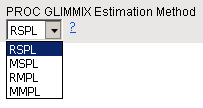PROC GLIMMIX Estimation Method
Use the drop-down menu to specify the estimation method to be used for Binary, Nominal, or Ordinal trait types and a model that includes random effects. PROC GLIMMIX is used to perform the estimation.

|
Method: |
Definition: |
|
RSPL |
Residual Pseudo-Likelihood method in which the expansion locus of the expansion is the vector of random effects solutions. |
|
MSPL |
Maximum Pseudo-Likelihood method in which the expansion locus of the expansion is the vector of random effects solutions. |
|
RMPL |
Residual Pseudo-Likelihood method in which the expansion locus of the expansion is the mean of the random effects. |
|
MMPL |
Maximum Pseudo-Likelihood method in which the expansion locus of the expansion is the mean of the random effects. |
|
QUAD |
Provides the least biased estimates. This method works best with only a few observations per level of random effect because the calculations can be very slow. |
|
LAPLACE |
Serves as an effective intermediate method and it equivalent to QUAD with one quadrature point. |
Pseudo-likelihood methods for generalized linear mixed modelscan be cast in terms of Taylor series expansions (linearizations) of the GLMM.
Residual methods account for the fixed effects in the construction of the objective function, which reduces the bias in covariance parameter estimates. Estimation methods involving Taylor series create pseudo-data for each optimization. Those data are transformed to have zero mean in a residual method. While the covariance parameter estimates in a residual method are the maximum likelihood estimates for the transformed problem, the fixed-effects estimates are (estimated) generalized least squares estimates. In a likelihood method that is not residual based, both the covariance parameters and the fixed-effects estimates are maximum likelihood estimates, but the former are known to have greater bias. In some problems, residual likelihood estimates of covariance parameters are unbiased.
Refer to the SAS PROC GLIMMIX documentation for additional details.
To Specify the Estimation Method:
| 8 | Make sure that the trait under investigation is either binary, nominal, or ordinal. |
| 8 | Select the desired method using the drop-down menu. |